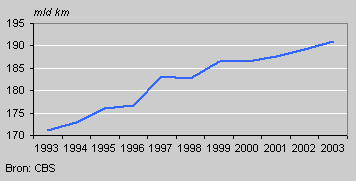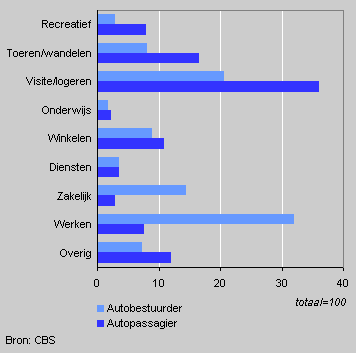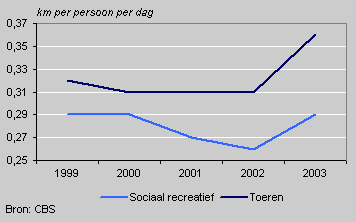Cyclists cover more kilometres in 2003

Altogether people in the Netherlands covered a distance of 191 billion kilometres in 2003, i.e. 1.6 billion kilometres or nearly 1 percent more than in the previous year. The number of kilometres travelled by car and by bicycle grew considerably. The total distance covered by public transport fell.
Kilometres travelled by the Dutch population

The average daily distance covered per person in 2003 was 32 kilometres, the same as in the previous year.
Since 1993 total mobility of the Dutch population has risen by 11.6 percent. This is mainly caused by the population growth.
Kilometres travelled by car
Car use made the largest contribution to growing mobility. Since 1993 the total distance covered by car drivers has grown by 20.6 percent to 93 billion kilometres in 2003. The distance travelled by car passengers increased over the same period by 8.6 percent to more than 53 billion kilometres.
Car drivers/passengers by distance and motive, 2003

Out of every 100 kilometres travelled by an average car driver, 33 kilometres were travelled to and from work, nearly 21 kilometres were driven to visit or stay with relatives, friends, etc. and nearly 15 kilometres were covered for business purposes. Male drivers cover 2.5 times as many kilometres as their female counterparts. Female car passengers cover more kilometres than male passengers. Female car passengers cover a daily distance of 10 kilometres, whereas male car passengers travel only 6 kilometres daily.
More kilometres by bicycle
The distance covered by cyclists increased by 0.9 billion kilometres in 2003 to 13.9 billion kilometres, 7 percent up on 2002. People increasingly use bicycles for recreational purposes.
Average distance covered by bicycle

Three times a day
On average people in the Netherlands travel three times a day. Nearly half of these movements take place by car, as drivers or passengers. More than a quarter take place by bicycle, and about 5 percent by public transport.
Hermine Molnár-In het Veld